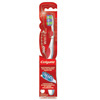Taking Care Of Your Teeth
Thanks to better at-home care and in-office dental treatments, more people are keeping their teeth throughout their lives. Some diseases and conditions can make dental disease and tooth loss more likely. But most of us have a good deal of control over whether we keep our teeth into old age.

Brushing
Most of us learned to brush our teeth when we were children. We have stuck with the same brushing technique into adulthood. Unfortunately, many of us learned how to brush the wrong way. And even if we learned the right way, we might not always stick to it. Brushing correctly is tricky. You want to remove plaque without brushing too hard and damaging your gums.
There are different ways to brush correctly. Your dentist or dental hygienist can show you the method that might be best for you.
Here are a few general pointers about brushing:
- Brush at least twice a day - One of those times should be just before you go to bed. When you sleep, your mouth gets drier. This makes it easier for acids from bacteria to attack your teeth. Also try to brush in the morning, either before or after breakfast. After breakfast is better. That way, bits of food are removed. But if you eat in your car or at work, or skip breakfast, brush first thing in the morning. This will get rid of the plaque that built up overnight.
- Brush no more than three times a day - Brushing after lunch will give you a good midday cleaning. But brushing too often can damage your gums.
- Brush lightly - Brushing too hard can damage your gums. It can cause them to recede (move away from the teeth). Plaque attaches to teeth like jam sticks to a spoon. It can’t be totally removed by rinsing, but a light brushing will do the trick. Once plaque has hardened into calculus (tartar), brushing can’t remove it. If you think you might brush too hard, hold your toothbrush the same way you hold a pen. This encourages a lighter stroke.
- Brush for at least two minutes - Set a timer if you have to, but don’t skimp on brushing time. Two minutes is the minimum time you need to clean all of your teeth. Many people brush for the length of a song on the radio. That acts as a good reminder to brush each tooth thoroughly.
- Have a standard routine for brushing - Try to brush your teeth in the same order every day. This can help you cover every area of your mouth. If you do this routinely, it will become second nature. For example, you can brush the outer sides of your teeth from left to right across the top, then move to the inside and brush right to left. Repeat the pattern for your lower teeth.
- Always use a toothbrush with “soft” or “extra soft” bristles - The harder the brush, the greater the risk of harming your gums.
- Change your toothbrush regularly - Throw away your old toothbrush after three months or when the bristles start to flare, whichever comes first. If your bristles flare much sooner than every three months, you may be brushing too hard. Try easing up.
- Electric is fine, but not always necessary - Electric or power-assisted toothbrushes are a fine alternative to manual brushes. They are especially useful for people who don’t always use proper brushing techniques. They also are a good choice for people with physical limitations that make brushing difficult. Use a powered toothbrush for at least two minutes, and don’t press too hard.
Toothbrush Tips
How can I take care of my toothbrush?
Toothbrushes can harbor germs and bacteria, we call them Invisible Nasties. To keep your toothbrush and yourself healthy:
- Make sure you let your toothbrush dry out between uses.
- After using your toothbrush, shake it vigorously under tap water and store it in an upright position so that it can air out.
How often should I change my toothbrush?
Dentists recommend that you should change your toothbrush at least every three months.
Studies show that after three months of normal wear and tear, toothbrushes are less effective at removing plaque from teeth and gums compared to new ones. The bristles break down and lose their effectiveness in getting to all those tricky corners around your teeth.
It’s also important to change your toothbrush after you’ve had a cold, the flu, mouth infection or a sore throat. That’s because germs can hide in toothbrush bristles and lead to re-infection.
Colgate* offers a complete line of toothbrushes, each designed to meet your specific oral care needs. As unique as each brush is, you can count on all of them to help remove plaque from teeth and gums. Improve the effectiveness of your brush and lower the chance of carrying germs and bacteria by following the care tips outlined below.
What Is the Right Way to Brush?
Proper brushing takes at least two minutes - that’s right, 120 seconds! Most adults do not come close to brushing that long. To get a feel for the time involved, try using a stopwatch. To properly brush your teeth, use short, gentle strokes, paying extra attention to the gumline, hard-to-reach back teeth and areas around fillings, crowns or other restoration. Concentrate on thoroughly cleaning each section as follows:
- Clean the outer surfaces of your upper teeth, then your lower teeth
- Clean the chewing surfaces
- For fresher breath, be sure to brush your tongue, too
How often should I brush my teeth?
Brushing twice a day with a fluoride toothpaste has been proven to reduce the risk of tooth decay.

Source: Colgate-Palmolive Company ©2012


